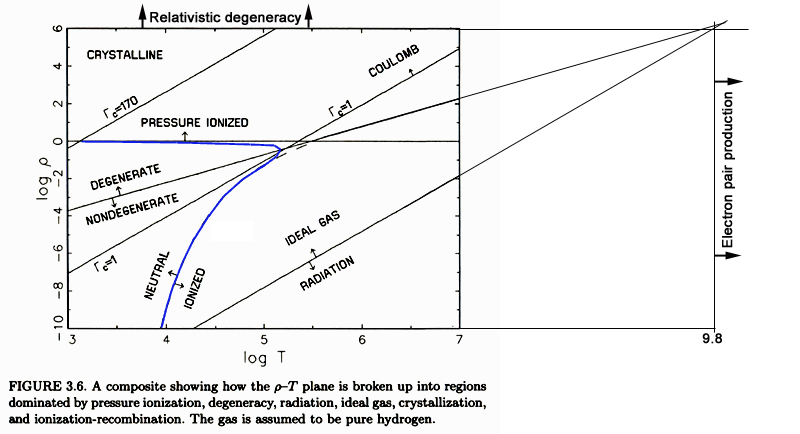
4.4D. Fermi-Dirac statisitics
Elementary statistical mechanics leads to the following expression for the number of particles of species i in phase-space volume d 3r d 3p :
ni(p) d 3r d 3p = (d 3r d 3p / h3) ∑ j gj {e [−μi + εj + ε(p)] / kT ± 1}−1 .
εj = mc 2
ε(p) = mc 2
{[1 + (p/mc)2 ]1/2 − 1}
v(p) = ∂ε/∂p =
(p/m) [1 + (p/mc)2 ]−1/2
P = (1/3) ∫ n(p) pv dp .
Individual Fermi particles have g = 2 and the ±-sign reverting to +. With isotropy we have
n(p) dp = 2 (4πp2dp / h3) {e [−μ + mc 2 + ε(p)] / kT + 1}−1 /cm3.
a. Complete degeneracy
Consider the 'exponential' part of the distribution,
F(ε) ≡ {e [ε − (μ −
mc 2)] / kT + 1}−1.
As T → 0, F(ε) → 1 for
ε > μ − mc 2,
and F(ε) → 0 for
ε < μ − mc 2.
We define the Fermi energy εF ≡ μ − mc 2,
or conversely μ = εF + mc 2.
To find how these quantities depend on number density, let x ≡ p/mc,
and consider the scaled Fermi momentum xF that corresponds to
εF through the ε(p) relation above.
Now integrate the total density over momenta as
n = (8π/h3) ∫opF p2dp = 8π(mc/h)3 ∫oxF x2dx = (8π/3) (mc/h)3 xF3.
Substituting values for electrons gives ne = 5.865×1029 xF3.
Carrying out the pressure integral gives
P = (8π/3) (mc/h)3 mc2
∫oxF x4
(1 + x2)−1/2 dx ≡ A f (xF)
A = (π/3) (mc/h)3 mc2 =
6.002×1022 dyne/cm2 for electrons,
f (xF) = xF (2xF2 − 3)
(1 + xF2)1/2 + 3sinh−1xF .
A similar expression may be written for the internal energy E(xF).
These expressions cover the range from non-relativistic to relativistic. Converting xF to ne and then to ρ via ne = ρNA/μe gives
Pe = 1.004×1013
(ρ/μe)5/3 in the non-relativistic limit, and
Pe = 1.243×1015
(ρ/μe)4/3 in the relativistic limit
(relativistic effects become important at about
ρ/μe = 106 ).
b. White dwarfs
At this point in their discussion, H&K briefly discuss the application to white dwarfs, referring
to an admittedly approximate constant-density model.
We could attempt to apply our 2-layer model with slightly more accurate results.
A properly integrated polytropic model results in the classical
Chandrasekhar relativistic limit
Mc = 1.456 (2/μe)2 Mo ,
where Mo is the mass of the Sun.
c. Partial degeneracy
As one raises the temperature at any one density, the degeneracy becomes partial in the neighborhood
of kT ≈ εF.
For electrons, this transition occurs at
ρ/μe ≈ 6×10−9 T 3/2
non-relativistic,
ρ/μe ≈ 5×10−24 T 3
relativistic (the cross-over is at about T = 1010,
ρ/μe = 106 ).
A good model must treat partial degeneracy for densities within a factor of 10 on either side of this boundary. In the past, modelers have used various power-law expansions or some graded combination of degenerate/non-degenerate limits in the boundary regime, but today they use either pre-prepared tables or direct integration.
Below is H&K's figure showing state regimes on the ρ,T plane.
